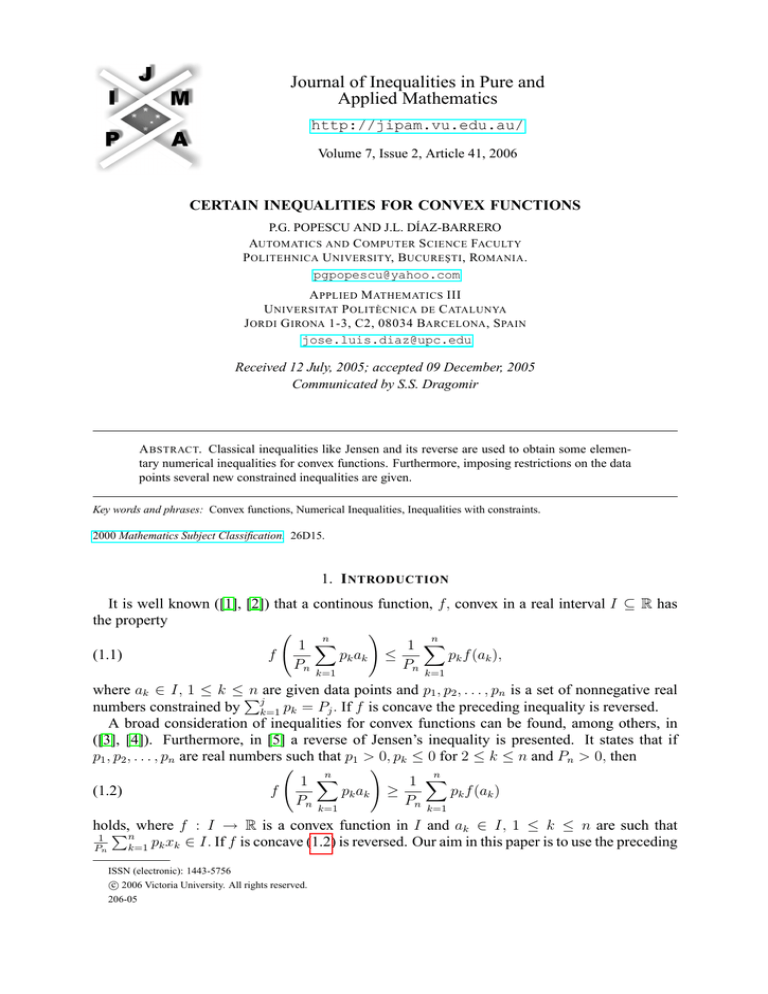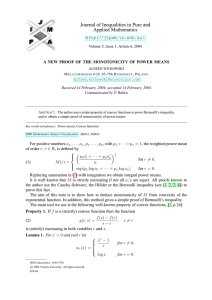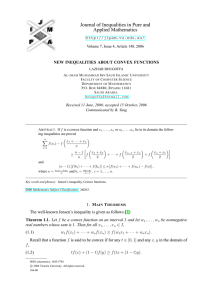
Journal of Inequalities in Pure and
Applied Mathematics
http://jipam.vu.edu.au/
Volume 7, Issue 2, Article 41, 2006
CERTAIN INEQUALITIES FOR CONVEX FUNCTIONS
P.G. POPESCU AND J.L. DÍAZ-BARRERO
AUTOMATICS AND C OMPUTER S CIENCE FACULTY
P OLITEHNICA U NIVERSITY, B UCURE ŞTI , ROMANIA .
pgpopescu@yahoo.com
A PPLIED M ATHEMATICS III
U NIVERSITAT P OLITÈCNICA DE C ATALUNYA
J ORDI G IRONA 1-3, C2, 08034 BARCELONA , S PAIN
jose.luis.diaz@upc.edu
Received 12 July, 2005; accepted 09 December, 2005
Communicated by S.S. Dragomir
A BSTRACT. Classical inequalities like Jensen and its reverse are used to obtain some elementary numerical inequalities for convex functions. Furthermore, imposing restrictions on the data
points several new constrained inequalities are given.
Key words and phrases: Convex functions, Numerical Inequalities, Inequalities with constraints.
2000 Mathematics Subject Classification. 26D15.
1. I NTRODUCTION
It is well known ([1], [2]) that a continous function, f, convex in a real interval I ⊆ R has
the property
!
n
n
1 X
1 X
(1.1)
f
p k ak ≤
pk f (ak ),
Pn k=1
Pn k=1
where ak ∈ I, 1 ≤ k ≤P
n are given data points and p1 , p2 , . . . , pn is a set of nonnegative real
numbers constrained by jk=1 pk = Pj . If f is concave the preceding inequality is reversed.
A broad consideration of inequalities for convex functions can be found, among others, in
([3], [4]). Furthermore, in [5] a reverse of Jensen’s inequality is presented. It states that if
p1 , p2 , . . . , pn are real numbers such that p1 > 0, pk ≤ 0 for 2 ≤ k ≤ n and Pn > 0, then
!
n
n
1 X
1 X
(1.2)
f
p k ak ≥
pk f (ak )
Pn k=1
Pn k=1
holds,
Pn where f : I → R is a convex function in I and ak ∈ I, 1 ≤ k ≤ n are such that
1
k=1 pk xk ∈ I. If f is concave (1.2) is reversed. Our aim in this paper is to use the preceding
Pn
ISSN (electronic): 1443-5756
c 2006 Victoria University. All rights reserved.
206-05
2
P.G. P OPESCU AND J.L. D ÍAZ -BARRERO
results to get new inequalities for convex functions. In addition, when the xk ’s are constrained
some inequalities are obtained.
2. U NCONSTRAINED I NEQUALITIES
In the sequel, applying the preceding results and some numerical identities, some elementary
inequalities are obtained. We begin with:
Theorem 2.1. Let a0 , a1 , . . . , an be nonnegative real numbers. Then, the following inequality
" n #
" n #" n #2
X n ak
X n
1 X n
eak
exp
≤ n
(1 + ak )
8 k=0 k (1 + ak )2
k
k 2n
k=0
k=0
holds.
n
n
et
Proof. Since f (t) = (1+t)
2 , 0 ≤ k ≤ n, into
2 is convex in [0, +∞), then setting pk =
k
Pn
n
(1.1) and taking into account the well known identity k=0 k = 2n , we have
!"
#−2
n n n X
1 X n
1 X n
eak
n ak
exp
1
+
a
≤
.
k
n
n
n
2
k
2
2
k
2
k
(1
+
a
k)
k=0
k=0
k=0
After rearranging terms, the inequality claimed immediately follows and the proof is complete.
Pj
Theorem 2.2. Let p1 , p2 , . . . , pn be a set of nonnegative real numbers constrained by k=1 pk =
Pj . If a1 , a2 , . . . , an are positive real numbers, then
v
" n # P1
!2
u
n
n
q
p
n
k
u
Y
X
X
1
1
ak + 1 + a2k
≤
pk ak + t1 +
pk ak
P
Pn k=1
n
k=1
k=1
holds.
√
Proof. Let f : (0, +∞) → R be the function defined by f (t) = ln(t + 1 + t2 ). Then, we have
1
00
√ t 2 3 ≤ 0. Therefore, f is concave and applying (1.1)
f 0 (t) = √1+t
2 > 0 and f (t) = −
(1+t )
yields
v
u
n
u
1 X
ln
pk ak + t1 +
Pn k=1
n
1 X
p k ak
Pn k=1
!2
" n pk # P1n
n
q
q
Y
1 X
≥
pk ln ak + 1 + a2k = ln
ak + 1 + a2k
.
Pn k=1
k=1
Taking into account that f (t) = log(t) is injective, the statement immediately follows and this
completes the proof.
1
Setting pk = , 1 ≤ k ≤ n into the preceding result we get
n
Corollary 2.3. Let a1 , a2 , . . . , an be a set of positive real numbers. Then
v
!2
u
n
n
n
q
1/n
u
Y
X
1 X
ak + 1 + a2k
≤
ak + tn2 +
ak
n
k=1
k=1
k=1
J. Inequal. Pure and Appl. Math., 7(2) Art. 41, 2006
http://jipam.vu.edu.au/
C ERTAIN I NEQUALITIES FOR C ONVEX F UNCTIONS
3
holds.
Let Tn be the nth triangular number defined by Tn =
n into the preceding result, we get
n(n+1)
.
2
Then, setting ak = Tk , 1 ≤ k ≤
Corollary 2.4. For all n ≥ 1,
n1
n q
q
Y
1
2
2
Tk + 1 + Tk
≤
Tn+1 + 9 + Tn+1
3
k=1
holds.
An interesting result involving Fibonacci numbers that can be proved using convex functions
is the following
Theorem 2.5. Let n be a positive integer and ` be a whole number. Then,
1
1
1
`
`
`
2
+
+ · · · + `−4 ≥ Fn2 Fn+1
F1 + F2 + ... + Fn
Fn
F1`−4 F2`−4
holds, where Fn is the nth Fibonacci number defined by F0 = 0, F1 = 1 and for all n ≥ 2,
Fn = Fn−1 + Fn−2 .
Proof. Taking into account that F12 + F22 + · · · + Fn2 = Fn Fn+1 , as is well known, and the
fact that the function f : (0, ∞) → R, defined by f (t) = 1/t is convex, we get after setting
F2
pi = Fn Fin+1 , 1 ≤ i ≤ n and ai = Fn Fi`−2 , 1 ≤ i ≤ n :
1
1
1
1
1
≤ 2
+
+ · · · + `−4 .
`
F1`
F`
Fn Fn+1 F1`−4 F2`−4
Fn
+ 2 + · · · + Fn
Fn+1
Fn+1
Fn+1
From the preceding expression immediately follows
1
1
1
`
`
`
2
F1 + F2 + · · · + Fn
+ `−4 + · · · + `−4 ≥ Fn2 Fn+1
,
`−4
F
F1
F2
n
and this completes the proof.
Finally, using the reverse Jensen’s inequality, we state and prove:
Theorem 2.6. Let a0 , a1 , . . . , an be positive real numbers such that a0 ≥ a1 ≥ · · · ≥ an and let
p0 = n(n + 1) and pk = −k, k = 1, 2, . . . , n. Then
! n
! 2
n
X
X pk
n+1
(2.1)
p k ak
≤
.
a
2
k
k=0
k=0
P
1
Proof. Setting f (t) = t , that is convex in (0, +∞), and taking into account that nk=1 k =
n(n+1)
from (1.2) we have
2
!
n
n
X
X
2
2
f
p k ak ≥
pk f (ak )
n(n + 1) k=0
n(n + 1) k=0
or
n
X
2
p k ak
n(n + 1) k=0
!−1
n
X pk
2
≥
n(n + 1) k=0 ak
from which, after rearranging terms, (2.1) immediately follows and the proof is complete.
J. Inequal. Pure and Appl. Math., 7(2) Art. 41, 2006
http://jipam.vu.edu.au/
4
P.G. P OPESCU AND J.L. D ÍAZ -BARRERO
3. C ONSTRAINED I NEQUALITIES
In the sequel, imposing restrictions on x1 , x2 , . . . , xn , some inequalities with constraints are
given. We begin with the following.
P
Theorem 3.1. Let p1 , p2 , . . . , pn ∈ [0, 1) be a set of real numbers constrained by jk=1 pk = Pj .
If x1 , x2 , . . . , xn are positive real numbers such that x11 + x12 + · · · + x1n = 1, then
!
! n
n
X
X 1
pk xk
≥ Pn2
pk
x
k=1
k=1 k
holds.
Proof. Taking into account the weighted AM-HM inequality, we have
n
1 X
Pn
.
pk xk ≥
P
pk
Pn k=1
n
k=1
xk
Since 0 ≤ pk < 1 for 1 ≤ k ≤ n, then
Pn
pk
xk
≤
1
p .
xkk
From which, we get
Pn
P
≥ Pn n
k=1
pk
xk
1
k=1 xpk
k
.
Then,
n
1 X
Pn
pk xk ≥ Pn
1
Pn k=1
k=1 xpk
k
and the statement immediately follows.
1
x1
+
n
X
1
xk
k=1
!2
Corollary 3.2. If x1 , x2 , . . . , xn are positive real numbers such that
then
n
1 X 1
≤
.
1/xk
n
k=1 xk
Proof. Setting pk = 1/xk , 1 ≤ k ≤ n into Theorem 3.1 yields
! n
!
!
n
n
X
X 1
X
1
pk xk
=n
≥
pk
1/xk
x
x
k
k=1
k=1
k=1 k
1
x2
+ ··· +
1
xn
= 1,
=1
completing the proof.
Finally, we give two inequalities similar to the ones obtained in [6] for the triangle.
Theorem 3.3. Let a, b and c be positive real numbers such that a + b + c = 1. Then, the
following inequality
1
aa(a+2b) · bb(b+2c) · cc(c+2a) ≥
3
holds.
Proof. Since a + b + c = 1, then a2 + b2 + c2 + 2(ab + bc + ca) = 1. Therefore, choosing
p1 = a2 , p2 = b2 , p3 = c2 , p4 = 2ab, p5 = 2bc, p6 = 2ca and x1 = 1/a, x2 = 1/b, x3 = 1/c,
J. Inequal. Pure and Appl. Math., 7(2) Art. 41, 2006
http://jipam.vu.edu.au/
C ERTAIN I NEQUALITIES FOR C ONVEX F UNCTIONS
5
x4 = 1/a, x5 = 1/b, x6 = 1/c, and applying Jensen’s inequality to the function f (t) = ln t that
is concave for all t ≥ 0, we obtain
1
1
1
21
21
21
ln a + b + c + 2ab + 2bc + 2ca
a
b
c
a
b
c
1
1
1
1
1
1
≥ a2 ln + b2 ln + c2 ln + 2ab ln + 2bc ln + 2ca ln ,
a
b
c
a
b
c
from which, we get
1
ln 3 ≥ ln
aa(a+2b) · bb(b+2c) · cc(c+2a)
and this completes the proof.
Theorem 3.4. Let a, b, c be positive numbers such that ab + bc + ca = abc. Then,
√
√
√
c
b
a b a c(a + b + c) ≥ abc
holds.
Proof. Since ab + bc + ca = abc, then a1 + 1b + 1c = 1. So, choosing p1 = a1 , p2 = 1b , p3 = 1c
and x1 = ab, x2 = bc, x3 = ca, and applying Jensen’s inequality to f (t) = ln t again, we get
1
1
1
ln (a + b + c) ≥ ln ab + ln bc + ln ca
a
b
c
or
1
1
1
1
1
1
a + b + c ≥ aa+c · bb+a · cc+b .
1
1
1
Now, taking into account that a1 + 1b + 1c = 1, we obtain: a + b + c ≥ a1− b · b1− c · c1− a , from
which the statement immediately follows and the proof is complete.
R EFERENCES
[1] J.L.W.V. JENSEN, Sur les fonctions convexes et les inégalités entre les valeurs moyennes, Acta
Math., 30 (1906), 175–193.
[2] Th.M. RASSIAS, Survey on Classical Inequalities, Kluwer Academic Publishers, Dordrecht, 2000.
[3] M. BENCZE, Octogon Mathematical Magazine Collection, 1993-2004.
[4] J.F. STEFFENSEN, On certain inequalities and methods of approximation, J. Institute Actuaries, 51
(1919), 279–297.
[5] P.M. VASIĆ AND J.E. PEČARIĆ, On Jensen inequality, Univ. Beograd. Publ. Elektrotehn Fak. Ser.
Mat. Fis., 639-677 (1979), 50–54.
[6] J.L. DÍAZ-BARRERO, Some cyclical inequalities for the triangle, J. Ineq. Pure and Appl. Math.,
6(1) (2005), Art. 20. [ONLINE: http://jipam.vu.edu.au/article.php?sid=489]
J. Inequal. Pure and Appl. Math., 7(2) Art. 41, 2006
http://jipam.vu.edu.au/






